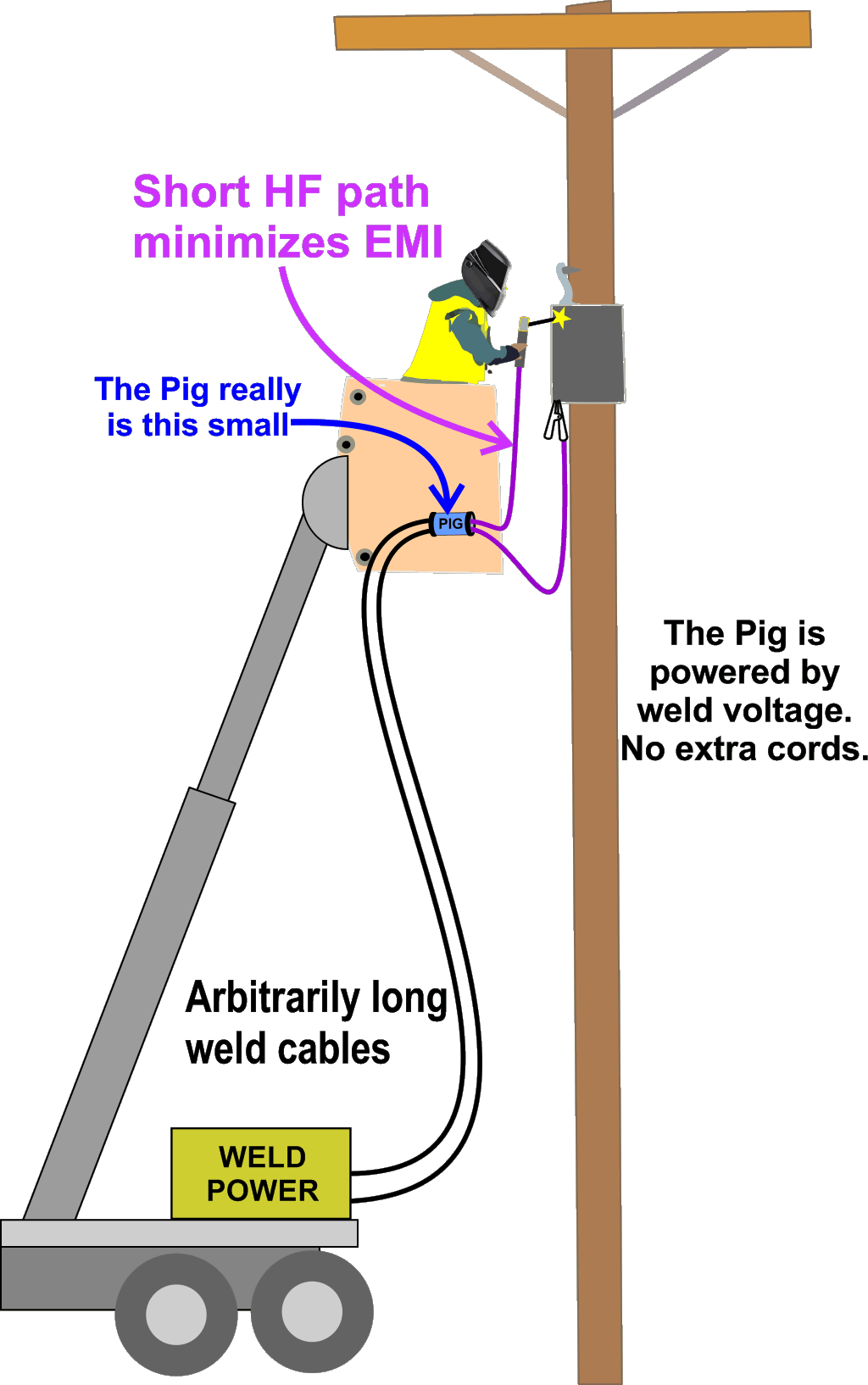
Arc Pig
Frequently Asked Questions
Q: What does the Arc Pig do?
A: The Pig gooses your weld voltage with sparks. The sparks have high voltage, but low current.
To strike an arc, put your electrode in position to weld,
press the trigger, and push the electrode in slowly until it ignites.
The Pig prevents tungsten contamination, by giving you no-touch strike.
It also tames hot starts, and reduces strike marks, since your electrode stays farther away.
While you weld, the Pig fires as needed to keep your arc ignited. (In other words, while you press the trigger, you get continuous-fire HF for TIG-welding aluminum.)
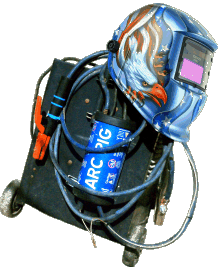 |
Minimal Added Clutter |
Q: How does the TIG Pig differ from the Arc Pig?
A: The TIG Pig is similar to the Arc Pig, except the TIG Pig allows water cooling and direct connection of standard WP-series TIG torches and water cables. Water cooling raises the TIG Pig's rated current from 250A (60% duty) to 1,000A (100% duty.) Otherwise, the Arc Pig and the TIG Pig are identical. In fact, most of their components come out of the same bins.
Q: If I touch it, will it hurt?
A: That depends on how you touch it. Surprisingly, the Pig's high-frequency output is not perceptible to humans, so if you grip your electrode firmly, you won't notice the HF,
unless it triggers your implanted defibrillator.
However, if you almost touch it, the Pig will try to start an arc to your finger.
This will tingle unpleasantly, like a continuous static spark, which will make you swear or squeal like a girl, depending on your temperament, and eventually give you a small, deep burn.
Be advised your welder's output voltage probably does hurt, if you get hold of both sides.
Q: Will the Pig let me TIG-weld aluminum with my stick welder?
A: Yes, customers do it all the time, but read this whole answer.
First, you need AC. You can't weld aluminum with DC, even with HF.
Continuous-fire HF keeps your AC TIG arc lit, which lets you weld aluminum, even with a stick-welding machine. (Provided you can turn off your machine's lift-start.)
Unfortunately, the term High Frequency has multiple meanings, which can be confusing.
The Pig gives you High-Frequency Ignition and Stabilization, similar to what you get by enabling
Continuous Fire Ignition on a high-end TIG machine.
This can be confusing, because a high-end TIG machine can also
do another kind of "high frequency," simply by cranking the Frequency knob past 60Hz, say 200Hz.
This is not the kind of HF you get from the Pig.
Welding at 200Hz gives two main benefits. First, 200Hz helps prevent arc extinction and rectification.
The Pig does the same thing, and probably cheaper.
Second, 200Hz gives a narrower weld channel. You cannot get this benefit from an Arc Pig.
Q: Can I TIG-weld aluminum with DC?
A: No. DCEN gives you penetration; DCEP gives you cleaning.
Aluminum TIG requires both, so you need AC, even with a Pig.
Q: Is it reliable?
A: Yes. The Pig has no moving parts, no relays, no contactors, no modes, no adjustments.
No maintenance, except to tighten the nuts and clean the fan.
In fact, the Pig has proved so reliable, we haven't needed to enforce the warranty time limit. Every Pig made since 2013 is still eligible for free repair. We don't promise to do this forever.
The Pig will let you know (by chirping) if it ever needs a new spark plug. ($5 on Ebay.)
Internally, all the Pig's capacitors are run at less than half their rated voltage and temperature.
Its four electrolytics are rated for 8,000 hours at twice the temperature and voltage they actually experience.
The fan is made by Orion, is rated for 50,000 hours, and only runs when it's needed.
The Pig monitors your weld voltage, so it always times its sparks perfectly,
regardless of your welder's power source.
Q: How much current can it handle?
A: The Arc Pig is rated for 250A at 60% duty, or 200A at 100% duty.
With water cooling, the TIG Pig is rated for 750A through its dry input, or 1000A through its wet input.
(Actually, it might handle more, but we can't say for sure because our test power supply only puts out 1000 Amps.)
Without water cooling, the TIG Pig has the same rated currest as the Arc Pig.
Q: Will it really ignite an arc without touching, even with my lousy welder?
A: Hell yes.
Q: How does it help with sheet metal?
A: The problem with sheet metal is you have to choose:
High weld current, which burns through the thin sheet,
or low weld current, which will not keep the &*(^#$^ arc ignited.
But with a Pig, just smile and crank your welder down to 30 amps.
You might be surprised by what happens, when you can devote your full attention to join quality.
Q: Does the Pig need 110V, or 220V?
A: Neither. At Arc Pig, we fear commitment, so the Pig draws its power
from your weld cables, and auto-adjusts to your welder's voltage.
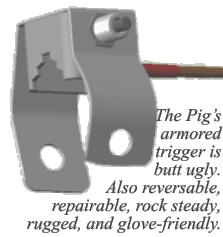
Q: Can I use it with an engine-driven welder?
A: Yes.
Q: Will it damage my welder?
A: No. If you connect your Pig as directed, its input studs will absorb the HF spark so it cannot
travel back up the cables to your welder.
However, any HF machine will broadcast radio interference to
all nearby wires, including those that lead to your welder.
This is not a problem for any decently built welder, even the $159 Harbor Freight inverter box.
But of course, we do not guarantee your welder is decent.
Furthermore, any electronic part can break. The Pig's input filter is simple and rugged (redundant ceramic capacitors)
but if it fails, HF sparks could reach your welder.
Therefore, the Pig Owner's Manual shows you
how to protect your welder, with a couple of 50-cent capacitors.
We even include a pair of capacitors with your purchase.
We don't bother to use them ourselves, but we think you should.
Q: Will I have to spend $200 for a remote trigger?
A: No. Your Pig comes complete with an armored trigger, which straps to your torch.
The trigger reverses for lefties, is the right size to find with your glove, and is ergonomic.
(That means comfortable.)
You can buy extra triggers from us, or make your own trigger from any mechanical switch.

Q: What if I accidentally zap the remote trigger?
A: No problem.
Q: Why is the trigger so ugly?
A: Because that is how we like it.
To complain about its appearance, contact a sympathetic female.
Q: Can the gas switch in a foot pedal be used as a trigger?
A: Yes with a big caveat. Anything that connects the Pig's trigger terminals will activate the HF, so the gas switch in a foot pedal makes a great Pig trigger.
HOWEVER, the Pig cannot coexist with another device on the same trigger circuit, because the Pig's trigger-isolation transformer has low resistance. So the Pig will trigger the other device, and the Pig's (low current) trigger circuit could even be burned out by a high current from the other device.
Conversely, if the other device has less than 10K ohms, the Pig will read it as a pressed trigger, and fire all the time.
Q: Can the trigger wire be longer than 8 feet?
A: Yes. If you need a longer wire, then use one. The Pig works fine with a trigger wire made from a 25-foot lamp cord.
Q: Can I use long weld cables?
A: Yes. Welders with built-in HF should use short output cables, since long cables convert the spark energy
into useless (and annoying) EMI radio broadcasts.
But the Pig sits in your weld cables, and is powered by your weld cables, so you can use it 200 feet from
your truck or the nearest wall outlet, because the high-frequency spark will only travel the last few feet.
Q: Do I need a special torch?
A: No. Standard electrode clamps and TIG torches work fine.
Feeding sparks into a spool gun is a bad idea.
Q: Do I need special weld cable?
A: No. Standard weld cable works perfectly, provided its insulation is not cracked.
Q: Do I need gas/water adapters to TIG weld?
A: No. TIG Pigs come complete with adapters for standard gas- and water-cooled WP-series torches.
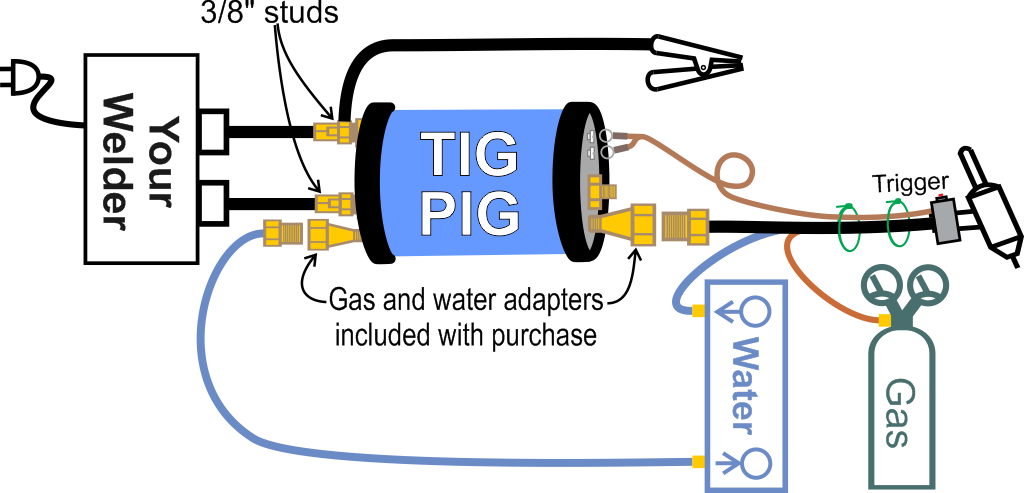
To TIG with an Arc Pig, just connect your gas/water block to the Pig's Output stud.
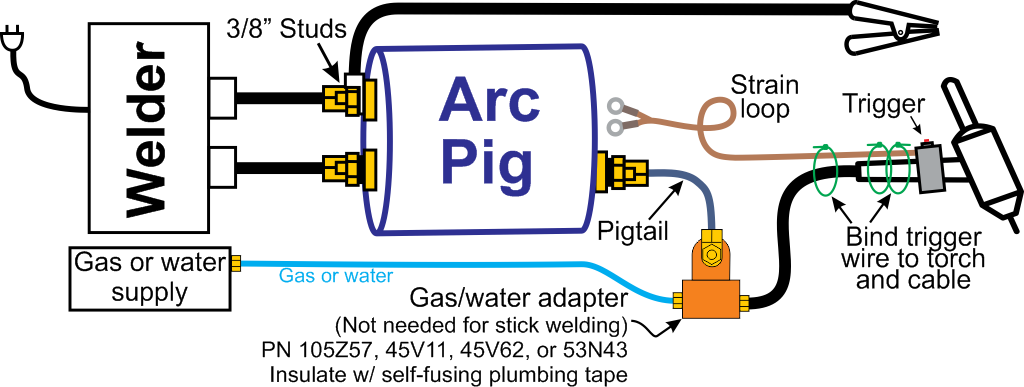
Q: Do I have to connect a second ground clamp?
A: No. Just wire the Pig into your existing cables, then ignore it.
Q: Will I have to buy propriety connectors?
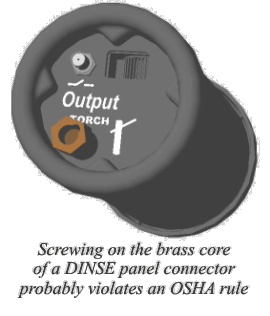
A: No. The Pig's trigger connectors are simple screw studs.
The power connectors are 3/8-16 threaded studs.
For your cables, we recommend hammer-on lugs, about $5 at Home Depot.
Alternatively, you can hammer out your own lugs from copper tubing.
If you prefer quick-change cables, you can make pigtails.
Alternatively, the Pig's studs accept the brass core of a DINSE panel connector (the large size, DINSE-35)
which you can buy online.
Q: What welders can I use?
A: The Pig works with almost any TIG or stick welder intended for a handheld torch, up to 60Hz.
For frequencies above 60Hz, the Pig attempts to fire at sensible moments, but we do not guarantee performance.
Q: Is the Pig useful for wire welding?
A: We don't think so, and the Pig's high-frequency sparks might damage a spool gun.
Q: Does the Pig support reverse polarity?
A: Yes. The Pig auto-adjusts to polarity, phase, and voltage. EN,EP,CC,CV,AC, or DC.
Q: Any limits on welder voltage?
A: The Pig works with any weld voltage, from uselessly low to illegally high. It needs
at least 24V to start up, and will refuse to spark (but will not be harmed) if you plug it into a U.S. wall socket.
Q: Any limits on welder frequency?
A: The Pig can fire up to 120 Hz. So it can fire every half-cycle for AC up to 60 Hz. For pulsed DC, the Pig can fire
every pulse up to 120 PPS, or every second pulse up to 240 PPS.
Q: Why is my aluminum bead so ugly?
A: Aluminum is fussy. If the arc stays lit, the HF is doing its job, and your bead problems are caused by something else, probably contamination. Your bead will be utterly destroyed by the tiniest amount of contamination from grease, water, barely-perceptible wind, bad gas, gas flow too low, gas flow too high, or even the metal itself, from previous welds.
Q: How far will the Pig's spark jump?
A: If you are using argon gas, the Pig's spark will jump 3/4" (20mm.) Yes, this is a wacky distance that you should never use.
In air (as when stick welding) the spark will jump anywhere from 1/16"-1/4" (1-7mm), depending mainly on the length of your torch cable,
and the temperature of your tip. You get the longest spark with a hot electrode, and a short cable.
Cable length affects spark voltage (and hence spark distance) more than it affects spark power. (For geeks, the cable is a capacitor.)
If you lengthen your torch cable from 8ft to 25ft, your spark will be less dramatic, but will have nearly the same ignition power.
Q: Is the Pig manufactured with sustainable methods?
A: At Arc Pig, we can honestly say sustainability is our second priority. (Reliability is our first.)
We carefully track our resource consumption, which we quantify in standardized green units that reflect
each individual resource's scarcity, as well as its importance to humans, measured by a deception-resistant system.
We review the results every quarter,
because at Arc Pig, we believe our number-two job is to consume less than we produce.
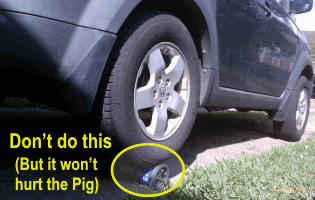
Q: How long will it take to install?
A: Your first installation should take half an hour,
including ten minutes fixing your mistakes. Your second installation should take fifteen minutes.
I can do it in five.
Q: Will the Pig help prevent arc rectification?
A: Yes. The Pig monitors your weld voltage each AC half-cycle (up to 60Hz) and
fires whenever your arc fails to ignite. This is how continuous fire HF ignition improves
an aluminum bead.
Q: Does the Pig control shield gas?
A: No. (TIG torches with built-in gas valves are widely available.)

Q: How long did it take to write that mission statement?
A: Look! A raccoon!
Q: Is the Pig ruggedized?
A: The Pig is designed to be dragged around by weld cables,
and will usually survive a three-foot drop onto concrete.
Its rigid enclosure is a quarter-inch thick.
Its only circuit board is coated with a waterproof film.
All its metal components are stainless or brass, excepting only the spark plug and its nut.
Internal wires are copper or stainless steel, never aluminum. Plastic is used only for engineering reasons,
never for cost, and some of the Pig's polymer parts could be made more cheaply from aircraft aluminum.
The Pig's distinctive, black bumpers may look like cheap thermoplastic, but they are actually flame-retardent Nylon 66.
Yes, the Pig's price is just stupidly cheap.
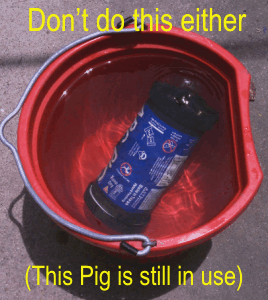
Q: Is the Pig waterproof?
A: Do not run the Pig wet. We only guaranty enclosure protection IP21S,
which means an un-powered, horizontal Pig will tolerate vertical rain.
If water gets in, high voltage might get out.
Also, water may wick into the Pig's internal wires and eventually corrode their connections.
So don't do it.
But, of course, we did it. We submerged a Pig in fresh water for fifteen minutes,
then shook it out and fired it up wet. We were not harmed, and neither was the Pig,
though it did not fire reliably until its spark gap dried out. We were a little surprised the blower worked.
We filmed it for our long video, but we kept screwing up the camera, and had to do it five times.
Afterward, the wet Pig was dried in a kitchen oven,
following the directions in the User's Manual.
Q: How often must I adjust the spark gap?
A: Never. However, if you wish, you can reduce the spark power by narrowing the spark gap. If you widen the gap too much, the Pig will chirp.
If you ever replace the plug, you MUST use a non-resistor plug! (Resistor plugs have an R in the part number. They appear to work, but give no spark power.) Try to find a spark plug with a projected tip, or you can use a non-projected tip and rip off the hook with pliers.
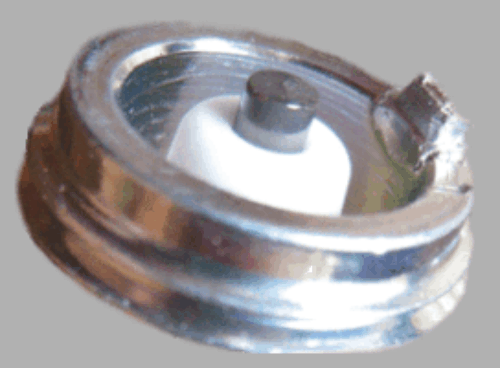 |
| What it looked like new |
Q: How often must I replace the spark plug?
A: The spark plug is good for about 100,000 arc strikes.
As a practical matter, the only way to wear out the spark plug is to use an AC welder with output voltage too low
to sustain an arc, so the Pig must fire continuously. The plug is good for a few hundred hours of continuous fire.
If the spark plug needs replacing, the Pig will let you know, by chirping every time the plug misfires.
Q: Why is it buzzing?
A: The buzz is the spark plug, and reminds you the Pig is firing.
The buzz is not loud enough to disrupt normal conversation,
but we are required to warn you to wear hearing protection. Wolf! Wolf! There's a wolf!
Q: Why is it beeping?
| After we turned on continuous fire and walked away for three weeks. |
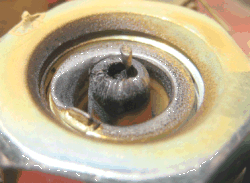 |
Still firing normally, but it's
about time for a new plug. |
A: At startup, the Pig beeps while it sample your weld voltage.
This is how the Pig knows when your weld voltage is approaching its maximum, which is the best time to fire.
Sampling the voltage takes 1/16 of a second, but the Pig does it over and over until it gets the
same reading twice. So if you hear more than two beeps at startup, it means the Pig
is waiting for your weld voltage to stabilize.
After startup, the Pig monitors its spark gap, and if the gap misfires, the Pig chirps.
Occasional misfires are normal, due to vagaries of air gap conductivity,
but constant chirping indicates a failing spark gap.
If the spark gap is shorted (this should never happen)
then the Pig will stop firing and beep continuously until you release the trigger.
In very heavy welding, or if you stick your electrode,
your weld voltage may fall so low (less than 12V for several AC cycles) that
the Pig has to shut itself down. When weld voltage returns, the Pig will wake up and beep.
And finally the Pig has a thermal alarm, which sounds totally different. One might even say musical.
You will know it, if you hear it.
Q: How long is the warranty?
A: If you are not satisfied with your Pig, return it in good condition within thirty days and we will
refund your money.
For two years after purchase, we will repair or replace any Arc Pig that fails for any reason. Even if the
reason is you. Hit it with an axe, we will fix it. Just tell us the truth.
| Close to your torch |
 |
| Reduces EMI |
Unofficially, we want to know about problems, so we fix every broken Pig we hear about, for free, no matter how old it is or why it failed.
However, this policy could end without notice.
The two main caveats are:
- You pay shipping to us. (We pay shipping back to you.)
- You get one free bonehead repair. (No limit if the bonehead was us.)
For details, read the inside cover of the
Pig Owner's Manual
Q: Is it safe?
A: Yes, with caveats. The Pig's high-frequency output is relatively safe to humans, but don't be stupid.
The Pig makes sparks. Act accordingly.
The HF spark is painless, if you grasp it firmly. If it jumps through the air to your skin, the HF spark gives you a zing and, eventually, a small, deep burn.
The Pig generates dangerously high internal voltage. Damage could allow this high voltage to escape. To be safe, if the Pig appears damaged,
do not use it until it has been tested by someone you don't like.
The Pig is powered by weld voltage, so even a damaged Pig cannot admit mains voltage into your weld cables.
With a Pig, your weld cables will broadcast more electronic interference than any other tool in your shop.
This means an Arc Pig can confuse or even damage electronic devices. We use many electronic devices
around our Pigs, including smart phones, digital oscilloscopes, computers, and power supplies.
The only problem we have seen is USB confusion, requiring us to unplug
then replug computer keyboards.
But maybe we just got lucky, and your devices might be more sensitive.
The Pig's intermittent current draw can boost the voltage of some welders.
Normally this effect is small,
but the Pig pays attention and adjusts its current draw if necessary,
so it will not boost your weld voltage higher than the normal output of a Lincoln buzz box.
Unless something goes wrong.
We apologize for this long answer, but anything shorter might attract looters.
Just remember your best protection is your gloves,
and the fact that our chief designer rarely bothers to wear them.

Copyright 2012-2019 Arc Pig Co.
